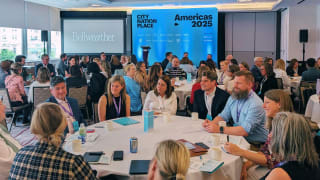The future of nation and place branding: Predictions for the next decade
by Jose Torres, CEO, Nation and Place Branding Global Director, Bloom Consulting
As City Nation Place celebrates ten years of connecting place branding professionals from around the world, we reached out to long-term partner Jose Torres, CEO, Nation, and Place Branding Global Director at Bloom Consulting, and sponsor of the very first City Nation Place event, to discover how he believes the world of place branding has evolved over the past decade.
In an increasingly interconnected world, nation and place branding play - and will continue to play - a critical role. As countries, regions, and cities vie for the hearts and minds of investors, global talent, and tourists, how they are perceived has a considerable impact on their economic development. Of that we're now certain. What is less certain is the future of the sector. However, by examining its trajectory so far and drawing on years of experience with place branding teams worldwide, we can make informed predictions.
This article will explore the global conditions and trends that have affected and will continue to influence nation and place branding in the years to come, presenting three possible future scenarios they might contribute to.
Three major factors influencing the development of nation and place branding
While every industry feels the effects of the geopolitical climate to some extent, nation and place branding are particularly sensitive to shifts, even starting from minor incidences of diplomatic tension, not to mention regime changes and wars. Estonia is an illustrative example. The country has successfully established – through proactive effort – a global reputation for being a digital society based on democratic values, while distancing itself from associations like “Eastern Europe” and “post-Soviet”.
Another hugely influential force in nation and place branding is and will continue to be technology. Since the advent of strategic management of nation and place branding in the 1990s, we've already observed the major changes brought on by the development of search engines and social media and how people and organisations use them. Our media consumption habits have completely transformed. Now, we speak of nation and place branding 2.0 to refer to the strategic management of a digital identity or the presence of a nation or place in the online environment, which I first brought up in my book, Nation Brand Builders.
More recently, advances in virtual reality, augmented reality, and blockchain technologies have been forcing brand builders to explore new avenues. We've seen the first countries and cities launch an official presence in the metaverse. Barbados, for example, became the first country to establish a virtual embassy, and Seoul and Dubai are investing heavily in their metaverse strategies.
All eyes are now on artificial intelligence. In the early stages of the public availability of tools such as ChatGPT, we've already witnessed initial adjustments as people start to use them as an alternative to search engines. We've also had a first taste of the havoc that deepfakes can bring. Credibility and regulation will remain significant issues in the near future that brand builders will need to consider in their work.
A third key factor, “setting the tone,” could be broadly defined as global concerns and sentiment, drawing from the social, economic, and environmental realms. Here I include climate change, as major decisions can no longer be made without addressing this scientific reality. Climate change, among other circumstances, is also leaving its mark on mental health, which is and will likely stay high on the public health agenda. Health events, such as pandemics, will also continue to influence nation and place branding, as seen in the case of COVID-19. Think back to Sweden's decision to keep most restrictions voluntary while other countries introduced strict lockdowns, for example.
Three possible future scenarios
In the three possible scenarios I envisage for the future, I consider the aforementioned trends and the “state of the world” today. While none of the scenarios are set in stone, they are based on over 20 years of experience as a practitioner in the field of nation and place branding. Here they are, in no particular order.
Fragmentation
One route that the world may go down is fragmentation or a shift towards more competition and less co-operation. This could lead to tighter regulations surrounding visas and international banking, less favourable tax rates, and other such measures with the potential to heavily impact trade, tourism, and investment. Trade wars are a possibility in this scenario.
Whether this pans out is heavily dependent on geopolitics. In particular, I believe that this will be influenced by relations between the USA and China. However, I do not see countries in the Middle East following this path of fragmentation or division. Indeed, I see stabilisation ahead for the region.
The “rise of the middle”
By the “rise of the middle” I mean power becoming more distributed among countries, with more “medium-sized” countries starting to have their say at the big table, diluting the dominant voices of the largest global economies. Brazil is one such “new player” to keep an eye on. In the latest Trade edition of the Bloom Consulting Country Brand Ranking ©, Brazil has climbed two places, solidifying its position as an economic force to be reckoned with. Saudi Arabia is also continuing its ascent and becoming a more noticeable voice in the global arena.
However, in this case, we may also experience the challenges associated with the first scenario: stricter regulation impeding the free movement of people, products, and services.
Harmonisation
Another possibility is a harmonisation of sorts. Under this scenario, narratives will focus less on competitive advantages and differences, and more on global causes and how countries, regions, and cities approach and mitigate shared issues, contributing to a more sustainable future. Refer to the efforts of Costa Rica as an example. With sustainability, innovation, and social progress among the values of its nation brand, many of the stories we hear of the country revolve around what its people are doing to protect biodiversity, promote the use of renewable energy, and improve access to health and education services, for example. Such messages have the potential to influence other countries' attitudes and policies, leading to a more united co-existence.
It may be that the future lies in a mix of the three scenarios. In any case, place branding teams should be open to walking down any of these paths, and this means laying the groundwork in advance.
A new era for nation and place branding
While we cannot know exactly what the future holds, we can boost our readiness to face the unknown by building resilient, non-partisan branding teams with a clear remit, introducing effective brand performance measurement systems, ensuring stakeholder alignment, and being prepared to manage crises.
I think we'll find the future less scary if we understand that the fundamental principles at the heart of nation and place branding remain the same; we'll just be operating in new conditions and with new tools.
As the second generation of nation and place branding professionals enters the workforce, the new perspectives and digital savviness will be a welcome addition. Finally, we may reach the long-awaited point of both consultants and clients understanding that nation and place branding are a much more complex and multifaceted endeavour than marketing alone, thus requiring support at a political level, budgets, and human resources to suit.









